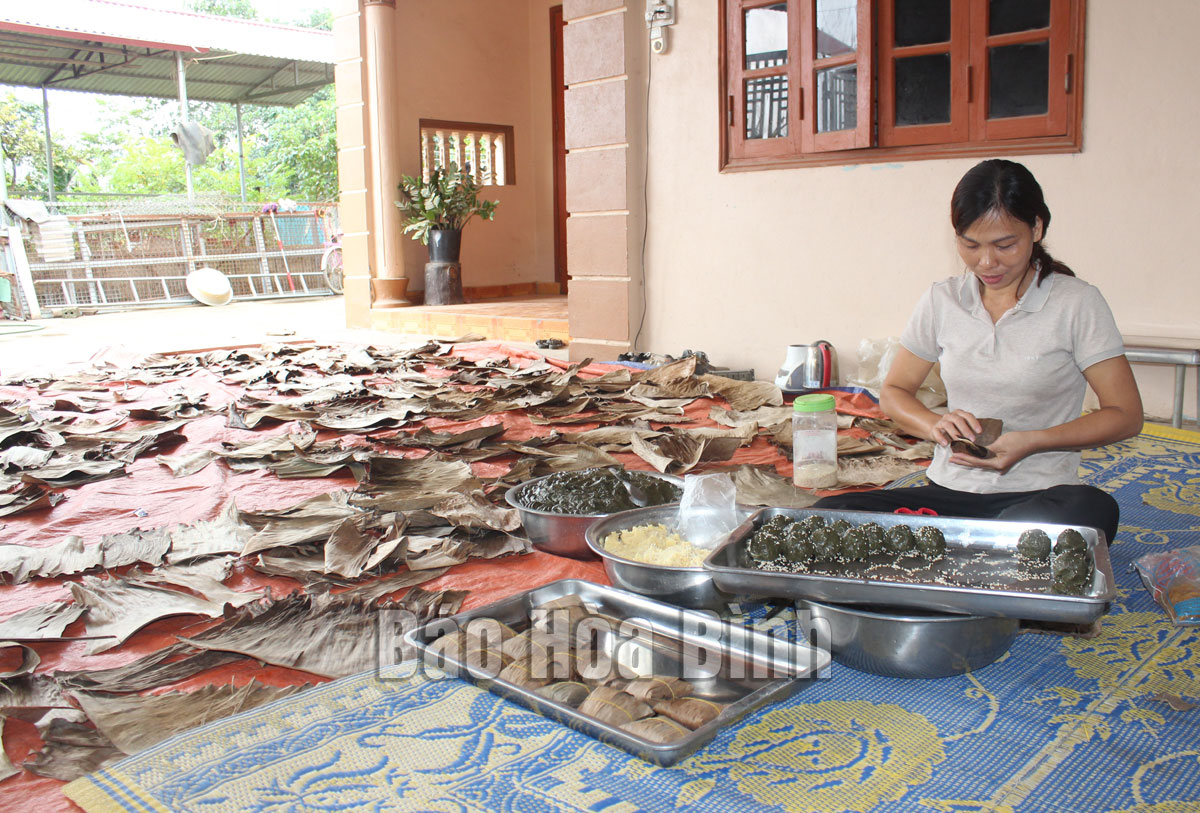



Wrapping of gai cakes requires carefulness and meticulousness of the baker.
The road along the downstream of Da River extends to the green cornfields. Along the canal, a small garden is interwoven with the lush green thorny leaves. The "capital” of Hop Thinh Gai cakes is located in the hamlets of the forrmer Hop Thin commune’s center such as Doc Lap, Hanh Phuc, etc. Normally, this area only has 1-2 housseholds making Gai cakes regularly. However, during Tet holidays, there are about more than 10 households making Gai cakes for sale. In addition, many other households make Gai cakes and Trung cakes for Tet holidays. From the very beginning of Doc Lap hamlet, we have seen that many households take advantage of the space from the yard, under the trees... to dry banana leaves for wrapping the cakes.
Ms. Nguyen Thi Lien (Doc Lap hamlet, Thinh Minh commune) – the owner of the establishement of Hung Lien Gai cakes says: Making Gai cakes is not too difficult but it is very sophisticated. From the selection of raw materials to each stage of making, it must be very meticulous and careful. Hop Thinh Gai cakes have had a "brand” for many years, so we must continue to preserve and promote such special delicious quality.
Making Gai cakes must be careful from choosing rice and beans. Rice must be the most fragrant sticky rice; Green beans are even, and the must be the yellow seeds not being mixed with the seeds of poor quality. Gai leaves are dull, not old, but not too young either. The best fatty meat for the filling is the nape fat for the thickness. The best wrapping leaves for the cakes are the dull and thick banana leaves to wrap the cakes squarely.
Every stage in the process of making Gai cakes is also very sophisticated, but perhaps the most thorough is washing the leaves. Gai leaves after drying is washed many times. The surface of the leaves is wide, rough with many small hairs, so it is very dusty, if the are not carefully washed, the cakes are gritty. Usually, Gai leaves are washed 4-5 times, only when the water is clear and there is no grit on the bottom of the pot, it meets the requirements.
The washing of the dried banana leaves must also be done carefully. The leaves must be washed, then dried under the roof of the yard, the canopy, if the are exposed to the yard in the sun, they can only be dried in the light sun as it is too sunny, the brittle dry leaves will not be able to wrap the cakes. The leaves for wrapping the cakes must be washed and dried, which is one of the important requirements so that the cakes are not moldy or stale.
The sticky rice after soaking is drained, the it is put into grinding. Gai leaves are stewed thoroughly for about 4 hours, then they are crushed until they are smooth and then they are mixed with sugar and glutinous flour. Normally, to have a sweet, fragrant honey flavor, the sugar used to mix with Gai leaves and sticky rice flour is the red sugar.
The cake filling is an important factor to make the delicious taste and characteristic of Hop Thinh Dai cakes. Sharing the secret to have a delicious filling, Ms. Lien says: After the green beans are well cooked, they are pounded by hand, then they are mixed with the fresh grated coconut and pork fat. The diced pork belly fat can be marinated and then lightly sun-dried. In addition, in the cake filling, there are additionally roasted peanuts, finely ground and mixed to increase the delicious taste. If the cake crust uses the red sugar, the filling use white sugar to give the filling a nice color and sweet taste. The cakes are wrapped with 2 turns of banana leaves to have a beautiful appearance, then they are steamed in about 2 hours. Steaming the cakes too long will make them flexible, tough, and last for a long time.
Previously, when there is no support machine, Gai leaves had to be pounded by hand. The mixing of leaves and powder had also to be done by hand, but now there are mills and mixers, so these stages are done by machines. The rice flour and Gai leaves ground and mixed by the machine are smooth, pure, and the cakes are more delicious. The steamer also liberates labor and helps the baker to actively adjust the appropriate steaming temperature to ensure that the cakes are always cooked evenly and deliciously.
On the occasion of Tet, many families choose Gai cakes and Chung cakes to burn incense to worship their grandparents and ancestors. Hop Thinh Gai cakes is also chosen by many families, agencies and units as the gifts for Tet. The cakes have a moderate sweetness, soft, chewy, and delicious filling. In particular, the cakes can be kept from 4, 5 days to 1 week without mold or spoilage. Those unique features and characteristics have made the "brand” of Hop Thinh Gai cakes - a homeland gift chosen by many people to enjoy.